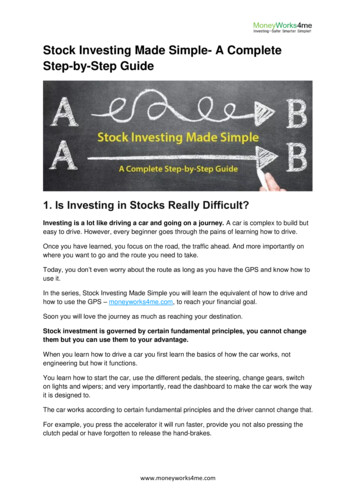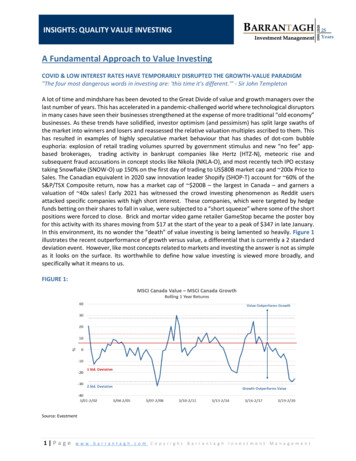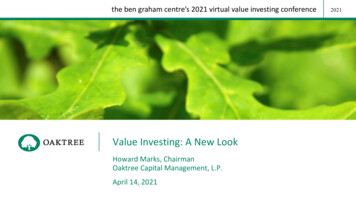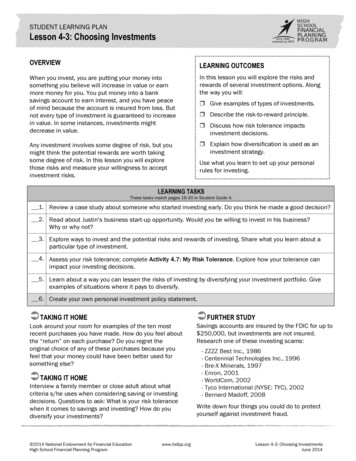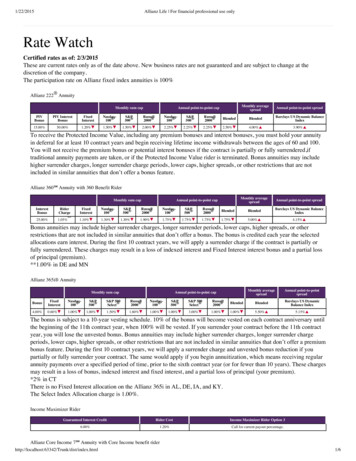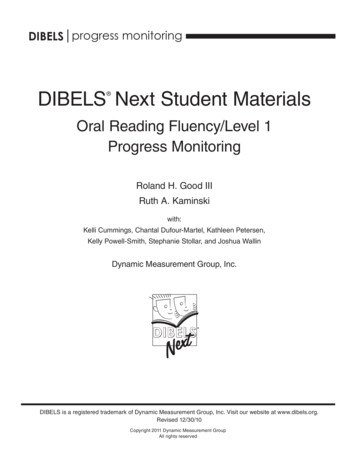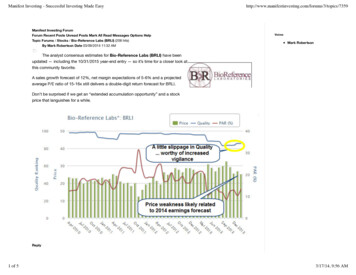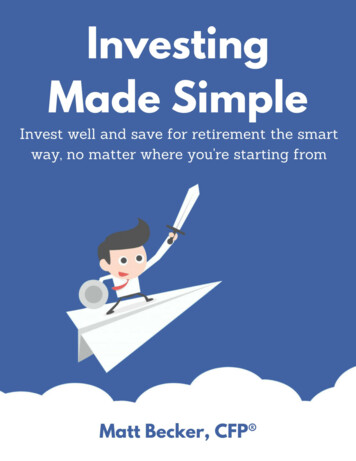
Transcription
What This Guide Is All About . 3Re-Thinking Retirement . 5What Does Financial Independence Look Like to You? . 9The Single Most Important Part of Your Investment Plan .14How Much Should You Be Saving?.19Where Should You Be Saving? .265 Fundamental Investment Truths .41The Investment Strategy That Works .56How to Beat 80% of Investors With 1% of the Effort .64Putting Your Plan in Place .71Conquering the Biggest Threat to Your Financial Independence.77Final Thoughts .81About the Author .82Disclaimer .832
This guide is for everyone who knows that it’s important to start investing but isn’t sure how todo it right.Investing can feel complicated, intimidating, and overwhelming. There are strange new words tolearn, a million decisions to make, and a whole lot of uncertainty about whether you’ll makemoney or lose it.It’s normal to be scared of investing. In fact, it’s normal to be so scared of investing that youavoid it entirely.But here’s the thing: investing doesn’t have to be scary, or complicated, or difficult. It canactually be pretty simple if you know what’s important and what isn’t. Which decisions matterand which don’t.You can create an investment plan that helps you reach your goals, no matter where you’restarting from.This guide will show you how to do it.By following the advice in this guide, you will walk away with the following: A clear set of specific goals that you’re working towards. A precise monthly savings target for reaching those goals and a plan for getting there. An investment strategy you understand that includes which accounts to use, how toinvest within each, and how to maintain it over the years. Confidence that you’re making good investment decisions.It doesn’t matter where you’re starting from or how much you know about investing. This guidemakes it as easy as possible for you to get yourself on the right track.Let’s get started!3
4
What are you investing for?Why are you working so hard to save money and put it into special accounts like 401(k)s andIRAs? Why should you divide that money between stocks, bonds and other “investments”you’ve never actually touched or even seen with your own eyes?What are you really trying to do here? What’s your end game? Heck, why did you buy thisguide?The party line in our society is that you’re saving for retirement. You know, that thing you get todo in your 60s, after you’ve kept a stable job for 40 years, and you finally have enough moneyto abruptly quit and enjoy your golden years.But that’s an old school way of thinking.There are more exciting possibilities available to people who are willing to think a little bitdifferently. And in this case, a small change in mindset can make a big difference in yourinvestment success.The big problem with the idea of “retirement” is the assumption that everybody lives their livesalong the same linear path and that everyone has to wait 30 or 40 years before having thefreedom to make their own choices about how to live.I don’t know about you, but I don’t want to wait. I’d like to be able to retire at some point, but Ialso want to enjoy myself along the way and give my family the freedom to live how we want tolive now.So when it comes to my personal financial plan, I don’t have a “retirement” goal. And when Iwork one-on-one with clients, I take the focus off retirement as well.Instead, I like to talk about financial independence.Here’s what financial independence means to me:“The freedom to make decisions based on what makes you happy insteadof what makes you money.”Let’s dive into some of the implications of this definition.From a purely financial standpoint, the idea of financial independence is somewhat similar to theidea of retirement. They both require you to have enough saved up so that you no longer haveto work for money.5
But from a psychological standpoint, there are some key differences that open up a world ofpossibility.Retirement is absolute. It’s an end point. You’re either still working or you’re not. Simple as that.Financial independence has degrees, and those degrees give you the freedom to make someexciting life choices a whole lot sooner.The end goal of financial independence is to eventually have enough money that you neverneed to work again. Not that you will definitely stop working (see below), but you have theoption to stop if you so choose.But financial independence can also simply mean having enough money to temporarily give upincome in pursuit of something you care about.Speaking from personal experience, it was that second type of financial independence thatallowed me to start this business. The savings we had in place allowed me to take time to growmy business into something profitable and sustainable while still handling my family’s needs.We weren’t fully financially independent. But we were independent enough to allow me to buildmy business from scratch.When you’re willing to think in degrees of financial independence, you open up a world ofopportunities over the course of your lifetime.While financial independence frees you from a dependence on income, it doesn’t assume thatyou stop working. After all, work done in support of a mission you believe in is one of the mostfulfilling ways you can spend your time.What’s more appealing: the idea of gritting your teeth through a terrible job just so you can quitdecades down the line, or the idea of spending your days doing work you love because yourfinancial position allows you to do so?Financial independence supports your quest to find fulfilling work you believe in, rather thanforcing you to wait for the day you get to quit a job you hate.When you stop working towards retirement and start working towards financial independence,you give yourself so much more opportunity to create a life you enjoy, both now and in thefuture.It’s no longer about reaching the same end point that everyone else reaches 30-40 years downthe road; it’s suddenly about dreaming up whatever kind of life you want and starting to worktowards it.6
I would encourage you to Google “financial independence retire early” and just start clicking.You’ll find all kinds of stories about people who have reached financial independence at alldifferent ages and are doing all kinds of interesting things with their lives.There’s Jim Collins, who has continually used his “F-you money” to chase varied interests,ensuring that his days are always spent doing something he enjoys.There’s Brandon Sutherland, who figured out how to take advantage of pretty much everyloophole in our tax code to quit his job and travel the world with his wife.There’s the infamous Mr. Money Mustache, who reached financial independence at 30 and nowspends his days writing, building houses, and teaching advanced math at his son’s school.And there are much simpler examples from the lives of my clients. I’ve worked with people whodecided to start a yoga studio, stay home with their kids, and go back to school. All of thosechoices required giving up income and having the savings in place to make up the difference.They required a degree of financial independence far before traditional retirement age.The point is this: you have OPTIONS. There are no rules. You get to decide what you want outof life.The rest is simply a matter of using the financial opportunities available to you to make that life areality.In the next chapter, I’ll walk you step-by-step through a process that will help you define exactlywhat financial independence looks like to you.7
8
Financial independence allows you to think about what you want out of life now instead ofhaving to wait 30-40 years, and that’s why I think it’s such a powerful mindset. It allows you toprioritize the things that are important to you instead of following a predetermined path.But there’s a question that still needs to be asked:What do you want out of life?This little question can be incredibly difficult to answer. It’s actually not a question we’re askedall that often and, without a little guidance, it can be tough to articulate specific goals that enableus to work towards something concrete.Here’s an 8-step process that takes this big vague question and turns it into specific steps youcan follow one at a time to get your answer.Important Note: This guide is all about helping you take action. There’s a lot of advice packedin here, but none of it is worth anything unless YOU do something with it.At the end of this section, and at many other points throughout the guide, you’ll see a big yellowbox marked TIME FOR ACTION! Every time you come to one of these boxes, please stopreading and follow the steps laid out for you. Doing so will ensure that you are actually puttingyour investment plan in place instead of just thinking about it.Take 15-30 minutes to sit by yourself, uninterrupted, and imagine that in the near future you’reliving a happy life. Not 40 years down the road when you’re old and gray, but a few years fromnow, maybe just five years down the line. Where are you? In the city or in the country? In a house or an apartment? What doesthe surrounding neighborhood look like? What does your family-life look like? Are you married? Dating? Do you have children?Have you adopted? What do you do together for fun? What does a regular day in yourhouse look like? Who are your friends? How often do you see them? What kinds of activities do you dotogether? What are you doing for work? What kinds of projects are you involved in? How is yourwork helping to make the world a better place? How much time do you spend working? What are your hobbies? How do you relax? What keeps you energized and excited?Could any of these side projects turn into a business venture?Let your mind wander as you ask yourself these questions. Don’t set limits or label anything as“unrealistic”. Think only of what a happy life looks like to YOU.9
A couple of days later, after you’ve let those thoughts settle in and have gone back to yourregular routine, repeat the exact same process again. This time, write things down as you thinkof them. Anything that’s part of the picture you form in your head should be put down on paper.This is the list that will eventually turn into goals.Now it’s time to put this list into some kind of priority order. You need some way of determiningwhich goals are most important and worth working towards first.So number each item or group them as high, medium, and low priorities; whatever works best tohelp you get some sense of which parts of your vision are most important to you.If you have a spouse or partner, ideally he or she has gone through the first three steps as welland now the two of you can come together and talk about it. And if your children are old enough,you should consider bringing them in on this discussion as well.This is a really fun process. After all, you’re talking about the life you want to build together andall the possibilities involved, and that’s exciting! If at any point this conversation starts to feel likea chore, drop it and come back another day when everyone is in the right mood.But it can also be a difficult process. No matter how much you love each other, you’re stilldifferent people and it’s only natural for you to have at least slightly different ideas for what youwant out of life. And those differences can cause some conflict.So here’s how I would approach this, at least on your first go-around:1. Focus first on anything you have in common. These will be great goals to prioritize first.2. For any goal that your spouse or partner has and you don’t, just try to hear WHY it’simportant to them and leave it at that. Listening and understanding is the first step.3. You will be re-visiting this process again in the future, so if there are goals or plans youreally disagree on I would simply leave it for now. Focus on the priorities you both thinkare important as a way to get started.This is one of my favorite steps.It’s obviously important to set priorities, but it’s just as helpful to determine the things that ARENOT important to you. By acknowledging that something isn’t important, you can intentionally10
take time, money and energy away from it so that you have more of those resources to focus onthings you DO care about.For a personal example, a few years ago I finally admitted to myself that I no longer cared aboutsports quite as much as I used to. That may sound silly, but this was a hard thing to admit. Alarge part of my life had revolved around sports for a long time.But that realization meant that I no longer felt like I needed ESPN, which meant that I could cutcable without really missing anything I truly valued.That freed up some money each month that made it easier to afford things like childcare andtravelling to see my family that lives 1,500 miles away. I never would have been able to do thatif I hadn’t intentionally acknowledged that watching ESPN was no longer on my list of priorities.Shifting expenses away from things you DIDN’T envision as part of your ideal life will give youmore money to put towards the things you DID envision.SMART goals are clearly defined in a way that makes it both easier and more likely to reachthem. And SMART is really just an acronym that says that any good goal has the followingcharacteristics: Specific Measureable Actionable Realistic TimelyBasically, it’s a way of taking a vague goal and turning it into a clear one so you can take realaction to accomplish it.For example, a vague goal might sound something like this: “I want to buy a house in a fewyears”.That goal is just isn’t specific enough. There’s no way to know exactly how to get started andthere’s no way to clearly measure your progress along the way.But you could turn it into a SMART goal by re-wording it to something like this: “I want to have 30,000 in a savings account for a down payment on a house in 5 years”.Now you have a specific dollar amount as your target, a specific timeline, a specific purpose,and a specific place you’re going to save the money. You can work backwards from there tofigure out exactly how much you need to be saving AND you can figure out exactly what kind ofprogress you’re making along the way.11
So, take some of your biggest priorities and do your best to turn them into SMART goals. Thatwill help you start to You can do all the planning in the world, but until you start taking action none of it will meananything.And the truth is that this is usually the scariest step. Taking action opens the possibility ofmaking all kinds of embarrassing mistakes, and the fear of making those mistakes often keepspeople from taking action.So let me spoil the surprise: you WILL make mistakes. We all do. I’ve made plenty of themmyself, some more than once, and continue to do so. It’s just part of the process.So the best you can do is acknowledge that mistakes will happen, take action anyways, andwhen you do make a mistake simply do your best to learn from it and keep moving forward.And the good news is that you’re not alone here. The rest of this guide is dedicated to helpingyou take the right actions so you make fewer mistakes.This is not a one-time process. Your life will change. Your goals will change. And it’s importantto acknowledge those changes so that you’re always working towards your current vision ofyour ideal life.Set a calendar reminder to re-visit this process once per year and update your vision.You can only get where you want to go if you know where you want to go. This process will helpyou make investment decisions that actually lead to a better, more enjoyable life.TIME FOR ACTION!Complete the following steps before moving on to the next chapter:1. Work through the first 6 steps above, both alone and, if relevant, with your spouse orpartner.2. Once you have your SMART goals, write them down in your Investment PlanWorkbook under the My Goals section.3. Set a calendar reminder to revisit this process in 12 months.12
13
No matter when you plan on reaching it, financial independence is a long-term goal. Even if youplan on being fully financially independent in a couple of years, you’ll still have to manage yourmoney in a way that allows it to last for the rest of your life.Long-term financial goals require investing, because investing is the most efficient way to growyour money over many years.So that’s what the rest of this guide will primarily be devoted to: showing you how to create aninvestment plan that you understand and that helps you reach financial independence along thetimeline you want.And the truth is that while there are a million things you could worry about as you start investing,there’s only one thing that really matters. And the good news is that it’s the one thing you’re incomplete control over:Your savings rate.It’s hard to appreciate just how powerful it is to save more money without a visual. So let’s makeone!We’re going to compare two people, Frank and Sarah. Both of them make 75,000 per year andare ready to start saving for financial independence, but they go about it in different ways.Frank frees up enough room in his budget to save 5% of his income. He also spends a lot oftime reading up on the finer points of investing, creates a smart investment strategy, and islucky enough to live through one of the stock market’s good periods. All of that gets him a 10%annual return from his investments. (Note: This is VERY high. A 7-8% return from the stockmarket is likely a more reasonable expectation.)Sarah takes NO time to learn anything about investing. In fact, she just puts all of her moneyinto a savings account at the local big bank which earns her a big fat 0% return. Maybe not thebest move in the world, BUT she also finds enough room in her budget to save 10% of herincome.So we have Frank, saving 5% of his income and earning 10% returns.And we have Sarah, saving 10% of her income and earning 0% returns.Who does better? Here’s the chart (next page):14
Savings Rate vs. Rate of ReturnYearFrankSarahAnnual Income0 3,750 7,500Frank & Sarah1 7,875 15,0002 12,413 22,500Frank3 17,404 30,000Savings Rate5%4 22,894 37,500Rate of Return10%5 28,934 45,0006 35,577 52,500Sarah7 42,885 60,000Savings Rate10%8 50,923 67,500Rate of Return0%9 59,765 75,00010 69,492 82,50011 80,191 90,00012 91,960 97,50013 104,906 105,00014 119,147 112,500 75,00014 Years!!!Remember, Frank is earning 10% returns every single year. Sarah is earning nothing.And it still takes 14 YEARS(!!!) before Frank’s incredible returns are able to overcome Sarah’ssavings rate. Sarah ends each of the first 13 years with more money.THAT is the power of saving.One more chart for you.This one assumes that you’re starting with 0 in savings and shows the number of years it takesto reach financial independence at different savings rates. It doesn’t matter what your income is,the math works out.Let’s take a look (chart on next page):15
Savings %85%90%95%100%Years UntilFinancial 54Under 3Under 20As you can see, even just a 5% increase in your savings rate can knock more than a decade offyour working years.It’s pretty simple really:The higher your savings rate, the quicker your path to financial independence.Eventually, the returns you earn start to matter a lot more. When you extend the Frank vs.Sarah chart from above, Frank’s balance starts growing significantly faster than Sarah’s afterYear 14 because he’s earning a much higher return.Once you have a lot of money in your account, you need to pay much closer attention to yourinvestment strategy in order to minimize mistakes and ensure that it’s aligned with your financialgoals. And we’ll spend plenty of time in this guide talking about how to do just that.But at the beginning, the returns you earn barely matter all. What matters is that you start savingenough now so that your account balance is eventually big enough for those returns to have animpact.16
In other words, you don’t have to put a lot of pressure on yourself to make the right investmentdecisions right from the beginning. Mistakes are okay, because the return you earn, good orbad, doesn’t have much of an impact anyways.BUT you do need to do two things if you want to reach financial independence:1. Start saving now with whatever amount you can handle, and2. Put most of your energy into increasing your savings rate to wherever it needs to be, noton choosing the “perfect” investments.Let’s talk about how to do that.17
18
Okay, so saving is important. Good to know. Now comes the million-dollar question:How much should you be saving?It’s a good question, and an important one. And by the end of this section you’re going to haveyour personal answer to it.Now, I don’t want to mislead you into thinking that there are any guarantees here. There aresimply too many variables in play to give you a definitive answer that will absolutely allow you toreach financial independence at a specific point in time.But I CAN give you a monthly savings target that puts you on the right track. You will still haveto re-evaluate your savings plan from time to time (and you can use this exact same process todo that), but this will give you as good a start as you can get.So that’s exactly what we’re going to be figuring out in this section: the monthly amount youshould be saving in order to get yourself on track to financial independence.This section makes use of the Financial Independence Savings Calculator spreadsheet thatyou received along with this guide, so you’ll want to have that open as you work through thissection.If you need to grab another copy of that calculator, you can do so here:https://momanddadmoney.com/fi-calculator.To access it, simply click the link, click File in the top menu, and either Make a copy to use itin Google Sheets or Download as to download it in Excel.Here are a few quick notes on using the calculator: I will be using “FI” as a shortened version of “financial independence” throughout thissection. Just wanted to give you a heads up to avoid any confusion! You will be doing all of your work in the FI Projection worksheet. The FI Assumptions & Notes worksheet explains some of the assumptions that go intothe calculator. You are welcome to review these and even change them if you wouldlike, though I would only change them if you are confident in what you’re doing. The Example FI Projection worksheet gives you an example of what it will look likeonce you’ve filled it out completely, using made up numbers for a made up couple.Open up the Financial Independence Savings Calculator and enter either your current age oryour spouse/partner’s age if he or she is older. For example, if you are 32 and your spouse is34, you would enter 34.19
In the Current FI Savings section of the spreadsheet, there are spaces to enter your currentbalance in any dedicated retirement/financial independence accounts, as well as those for yourspouse or partner.Once you enter your current balance for each account, the Current FI Savings field in theVariables section will automatically add them up to get your total current balance.You may not have a specific target age yet, but one of the fun parts of this calculator is that youcan enter different ages here to see what your savings target would be in each scenario. Andhonestly, I would encourage you to do just that.Play around with this field and note the savings target needed to reach financial independenceat different ages. That can help put some definite numbers around this question that may helpyou set your eventual goal.Along with your estimated FI age, your Estimated Monthly Expenses at FI is the big unknownthat will have a big impact on the savings needed to reach financial independence. Simply put,the lower your required expenses, the easier it will be to reach financial independence.And this is another variable that’s hard to know ahead of time. So what I would do is start withyour current monthly expenses, since that represents your current lifestyle. If your lifestyleremains consistent between now and when you reach financial independence, this estimate willbe reasonably accurate.If you don’t know how much you’re typically spending per month, I would simply make your bestguess for now. But for a more accurate view, I would suggest using a tool like Mint.com to trackyour spending for a few months. That information will be helpful for this projection and yourgeneral financial health.If you’d like, you can get a little more detailed by making some adjustments to your currentspending based on things you expect to add or remove once you’ve reached financialindependence. Here’s a quick list of things to consider if you want to do this: Any savings that’s really going towards expected irregular expenses like home repairs,car maintenance, etc. Health insurance premiums 1/12 of annual payments for things like car insurance Any spending you might like to add once you’re financially independent, like travel20
Financial independence savings (you will already be there!) A mortgage payment, if you plan on having it paid off College savings (unless you plan on reaching financial independence before your kidsare done with school) Life and disability insurance premiums (you may no longer need this coverage onceyou’re financially independent)There’s a lot of doom and gloom out there about Social Security, but the truth is that it’s in muchbetter shape than many people think. In fact, according to the 2016 Trustees Report on SocialSecurity, it should still be able to pay out about 74% of the current estimated benefits throughthe year 2090, even if no changes to the program are made.So it makes sense to factor it into your plans. What I like to do is get the full estimate of benefitsand then only count 50% of it in the calculation, just to be conservative. That’s exactly what we’lldo here.There are two different ways to get your estimated Social Security income. Both are describedbelow.Just a heads up, the first three steps are the same no matter which method you are using.If you have a spouse or partner, you can both go through this exercise and add the twonumbers together.I recommend you try this one first, just to get your statement and see where you stand.Here’s how to get your Social Security benefit statement:1. Go to http://www.ssa.gov/myaccount/.2. If you’ve done this before and have an account, you can click the “Sign In” button.3. Otherwise, you can click the “Create an Account” button and go through the process ofsetting up your account.4. Once you have an account, you can sign in and click the “Estimated Benefits” tab. Thisleads you to a page that shows your estimated benefits for a number of different SocialSecurity programs, including retirement.21
5. Under “Retirement”, you will have three different estimated benefit amounts dependingon when you plan to start claiming benefits. You can choose whichever one is mostrelevant for you and then:a. Enter the monthly benefit into the Estimated Social Security Income field ofyour Financial Independence Savings Calculator.b. Enter the age associated with that monthly benefit into the Estimated SocialSecurity Start Age field.If you haven’t accumulated enough work credits yet for it to display estimated benefits, or if youexpect your income to change in the future, you can use this next method instead.Here’s the step-by-step (same first 3 steps as Method #1):1. Go to http://www.ssa.gov/myaccount/.2. If you’ve done this before and have an account, you can click the “Sign In” button.3. Otherwise, you can click the “Create an Account” button and go through the process ofsetting up your account.4. Sign in, and this time click on the “Earnings Record” tab. Keep this open. You will use itin a minute.5. In a new browser window, go et.html.6. Fill out the information requested. Here are a few important notes:a. Unless you genuinely plan to stop working much earlier, and therefore stopearning an income, enter your “Age at retirement” as 67. Because even if youreach financial independence earlier, you may still be working (on something youlove) and earning money that counts towards your Social Security benefit.b. Leave the “Today’s dollars or future dollars” box marked as “today’s dollars”.c. For the “Annual earnings” boxes, you can refer back to the “Earnings Record”you opened up in Step 2 to fill in your income from previous years.d. For “Earnings in 2017 and later“, enter your estimated annual income goingforward. This will only significantly change the result if it’s significantly differentfrom what you’ve been earning to thi
Investing can feel complicated, intimidating, and overwhelming. There are strange new words to learn, a million decisions to make, and a whole lot of uncertainty about whether you’ll make money or lose it. It’s normal to be scared of investing. In fact, it’s normal
